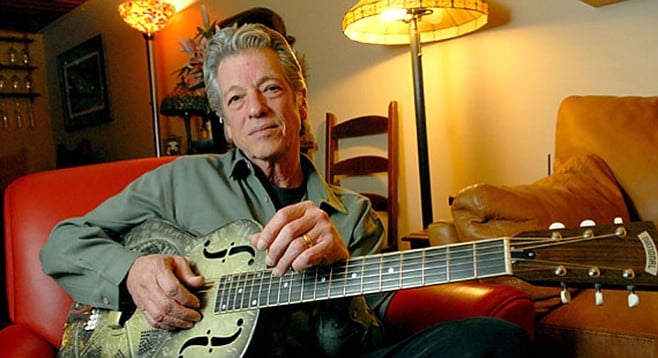 Facebook
Facebook
 X
X
 Instagram
Instagram
 TikTok
TikTok
 Youtube
Youtube

Inside the protected and ever-dwindling world that is modern blues music, John Hammond Jr. is a rock star. In a notable career that spans back to the 1960s, the Blues Hall of Famer and Grammy award winner has released more than 30 albums. Hammond’s career spans back in time to a far more liberal era in which youth culture as a whole embraced music in general. Keep in mind that Hammond’s debut, Big City Blues, was released in 1962, a couple of years before the Rolling Stones would introduce white America to what had previously been segregated from the mainstream and shuttled into a category known as “race music.” Band-less and acoustic, John Hammond Jr., son of a famous record producer he barely knew, played that music as if his life depended on it. He still does.
Because he descended from one of America’s wealthiest capitalists, one wonders if John Hammond Jr. was a disappointment to his family. The blues, after all, is not a road paved with much in the way of material comforts. And the friends he kept probably scared the hell out of them: a youthful (and then penniless) Jimi Hendrix, a post-Cream blues fanatic sporting a ’fro named Eric Clapton, and Bob Dylan, whom Hammond’s renowned father and namesake would eventually sign to a record deal.
John Hammond Jr., now gray-headed, will turn 74 this year. He says he came to guitar when he was late into his teens, and after he heard his first round of plantation blues, he never looked back. Funny thing — he’s mostly played covers all these years; only relatively recently has he begun to write his own blues: “When your back’s to the wall/ Do what you got to do/ Wait for a sign to come from above/ Got to take a stand/ When push comes to shove.” You feelin’ it?


Inside the protected and ever-dwindling world that is modern blues music, John Hammond Jr. is a rock star. In a notable career that spans back to the 1960s, the Blues Hall of Famer and Grammy award winner has released more than 30 albums. Hammond’s career spans back in time to a far more liberal era in which youth culture as a whole embraced music in general. Keep in mind that Hammond’s debut, Big City Blues, was released in 1962, a couple of years before the Rolling Stones would introduce white America to what had previously been segregated from the mainstream and shuttled into a category known as “race music.” Band-less and acoustic, John Hammond Jr., son of a famous record producer he barely knew, played that music as if his life depended on it. He still does.
Because he descended from one of America’s wealthiest capitalists, one wonders if John Hammond Jr. was a disappointment to his family. The blues, after all, is not a road paved with much in the way of material comforts. And the friends he kept probably scared the hell out of them: a youthful (and then penniless) Jimi Hendrix, a post-Cream blues fanatic sporting a ’fro named Eric Clapton, and Bob Dylan, whom Hammond’s renowned father and namesake would eventually sign to a record deal.
John Hammond Jr., now gray-headed, will turn 74 this year. He says he came to guitar when he was late into his teens, and after he heard his first round of plantation blues, he never looked back. Funny thing — he’s mostly played covers all these years; only relatively recently has he begun to write his own blues: “When your back’s to the wall/ Do what you got to do/ Wait for a sign to come from above/ Got to take a stand/ When push comes to shove.” You feelin’ it?
Comments